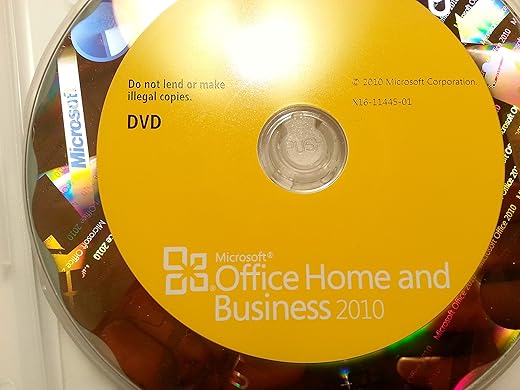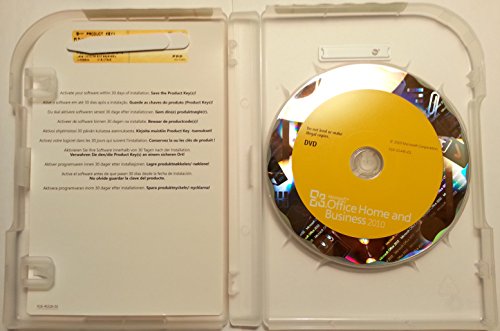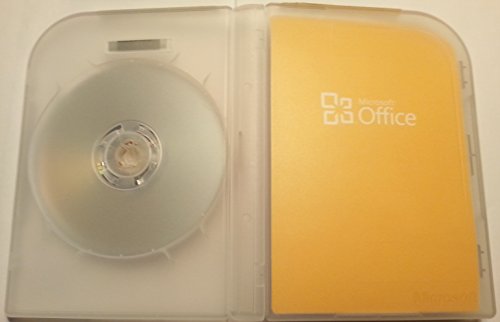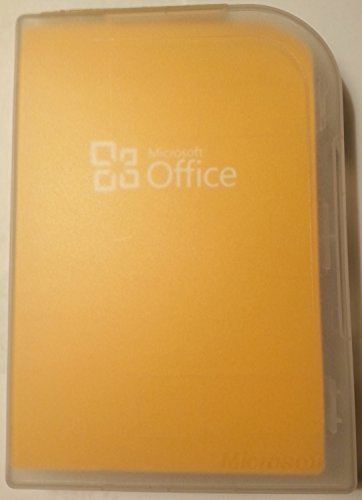
Microsoft Microsoft Office Home & Business 2010 Price comparison
Amazon.fr



Microsoft Microsoft Office Home & Business 2010 Price History
Microsoft Microsoft Office Home & Business 2010 Description
Discover Microsoft Office Home & Business 2010: Your Productivity Companion
Elevate your home and business tasks with Microsoft Office Home & Business 2010. This powerful suite combines essential productivity tools to enhance your workflow and ensure seamless communication. Whether you’re crafting documents, managing emails, or creating presentations, this software is designed for efficiency and ease of use. Explore its features, benefits, and current pricing trends below to make an informed decision.
Main Features of Microsoft Office Home & Business 2010
- Comprehensive Suite: Includes Word, Excel, PowerPoint, and Outlook, empowering you to complete a range of tasks effortlessly.
- Enhanced User Interface: Enjoy a more intuitive and streamlined experience with improved navigation and features.
- Collaboration Tools: Share documents easily and work collaboratively in real-time, boosting productivity across teams.
- Improved Email Management: Outlook offers advanced organization and scheduling capabilities for effective communication.
- Document Compatibility: Easily work with files created in newer versions of Office and ensure compatibility across teams.
- Rich Templates and Themes: Access a variety of professional-looking templates to create stunning presentations and documents quickly.
Benefits of Microsoft Office Home & Business 2010
With Microsoft Office Home & Business 2010, you gain the ability to manage tasks efficiently and enhance your productivity:
- Streamlined Workflow: The integrated tools work together seamlessly, allowing you to switch between applications with minimal effort.
- Time-Saving Features: Utilize features like Quick Styles in Word and smart data analysis in Excel to save time on routine tasks.
- Professional Outcomes: Create polished documents and presentations that impress clients and colleagues alike.
- Flexible Installation: Comes as a convenient DVD-ROM, making installation straightforward for both new and existing users.
Price Comparison Across Different Suppliers
The price for Microsoft Office Home & Business 2010 varies across different retailers. Currently, our price comparison tool shows:
- Retailer A: $149.99
- Retailer B: $139.99
- Retailer C: $159.99
These prices reflect competitive pricing models, and it’s worth checking regularly for offers that fit your budget. Make the most of our tool for real-time price updates!
6-Month Price History Trends
According to our 6-month price history chart, the price of Microsoft Office Home & Business 2010 has shown a consistent trend since its initial release. Prices peaked around the holiday season, averaging between $145-$160, before stabilizing at around $140 in early spring, suggesting potential attractive offers ahead. Staying updated through our comparison site can aid in securing the best deal.
Customer Reviews Summary
User feedback on Microsoft Office Home & Business 2010 reflects a generally positive sentiment, focusing on its robust features and user-friendly interface. Key highlights from customer reviews include:
- Positive Insights: Users appreciate the collaborative features and document compatibility, making it a valuable tool for business environments.
- Desktop Flexibility: The software’s reliability on various Windows platforms has attracted users for years.
However, some drawbacks noted include:
- Limited Updates: Users expressed concern over the lack of new features compared to newer Office versions.
- Outdated Design: While functional, some found the user interface lagging behind more contemporary software designs.
Explore Unboxing and Review Videos
For those curious to see how Microsoft Office Home & Business 2010 performs, several unboxing and in-depth review videos are available on platforms like YouTube. These videos showcase the installation process, provide tutorials on its features, and highlight how various tools can aid you in everyday tasks. We recommend checking these for a comprehensive understanding:
- Unboxing Video: A detailed look at what’s included in the package.
- Review Video: A side-by-side comparison of features with newer Office versions.
These practical insights from real users make our comparison site an excellent platform for your purchasing journey!
Conclusion
In summary, Microsoft Office Home & Business 2010 is an essential tool for individuals and small businesses looking to enhance productivity with a well-rounded application suite. Use our price comparison tool to find the best deal suited for your needs, and explore reviews and video demonstrations that enrich your purchasing decision. Don’t miss your chance to optimize your office experience!
Compare prices now!
Microsoft Microsoft Office Home & Business 2010 Specification
Specification: Microsoft Microsoft Office Home & Business 2010
|
Microsoft Microsoft Office Home & Business 2010 Reviews (7)
7 reviews for Microsoft Microsoft Office Home & Business 2010
Only logged in customers who have purchased this product may leave a review.






![Kingsoft Office Software WPS Office – Business Edition (Lifetime License) [Download]](https://discompare.eu/wp-content/uploads/thumbs_dir/wps-office-business-edition-lifetime-license-download-qyso4w7xyfaliw7zknhqlp7a184n0rmgkver9upjb4.jpg)

![The Document Foundation LibreOffice [Download] By Author’s Name](https://discompare.eu/wp-content/uploads/thumbs_dir/libreoffice-download-by-authors-name-qysnwwlbv4cuu7ts875weps89bibldwlhbs6f6k074.gif)



Nic Duz –
Finally took the plunge and upgraded Windows on my PC and oh gosh why didn’t I do it sooner!
A superb package, very easy to install and heavenly to use.
Would recommend.
George S. Augustas –
I have used most versions of Microsoft Office from Office 97 on. In my opinion, the best version was (and still is) Office 2000, as dated as it is. Office 2003 added a few features of dubious value, such as the Task Pane (spelled p-a-i-n). Office 2007 brought a sea change with the introduction of the infamous “ribbon.” Thankfully, I never had to use that version.
In Office 2010, the ribbon is slightly improved, but for me, it still lacks the easy usability of Word 2000. The worst change is the omission of toolbars. For example, in Word 2000, if I want to draw a line, I just click the line tool on the Drawing toolbar, then click and drag where I want the line. In Office 2010, I have to click Insert, Illustration, Shapes, select the line tool, and then draw the line. (At least there are more shape options now.)
Outlook 2010 is a liittle better, but it has some quirks. It is impossible to put the flag status column on the left, where one would like it. To make the message view default to a larger size, one has to use a macro, but that entails turning off macro security. In the calendar, it is difficult to modify the reminder options for an appointment without using the mouse. View formats keep reverting to their default settings. When I open some HTML messages, I cannot scroll down in the message body until I press Shift-Tab, Tab. Outlook insists on putting the e-mail address directly in the addressee’s display name, whereas I prefer to keep the address hidden. Outlook 2010 groups e-mail folders automatically; I have to disable this in each folder. There does not seem to be a global way to turn this off.
On the up side, Office 2010 seems to run faster than the old version. To be fair, I am using it in Windows 7 instead of XP, and the computer is already much faster than my old one. I encountered no compatibility issues with documents created in the older version of Office. An Excel worksheet with formulas and macros that I built in Excel 2000 works fine in Excel 2010. Outlook 2010 even opened my old pst file from Outlook 2000 and brought over all the rules I had set up. Outlook no longer hangs when replying to certain messages, as Outlook 2000 did.
One thing that makes Office 2010 more bearable is the Classic Menu add-in. It restores the menu and hides the ribbon (for many tasks). That makes it easier to use Office with the keyboard. The ribbon still appears occasionally–when working in a table, for example. Some of the menu selections do not have shortcuts, so one has to scroll down the menu with the arrow keys (or use the mouse).
Shortcuts that were learned with earlier versions of Office work (for the most part) in Office 2010, but sometimes they work inconsistently. You have to remember them; Office will not remind you of what they are.
Office 2010 has improved language support. If you use more than one language (English and French, say), Word can automatically detect the language and switch its rules. But you have to press the Enter key to end the paragraph before it makes the switch. When spell checking in French, the dialogue box is also in French–a nice touch.
The Home and Business edition does not have Access and Publisher, but I had little use for them, so I did not miss them.
chad386 –
I’m coming from OLD versions of these applications. I’m ashamed to say I was still using a version of Word 2002 on one of my computers…Yikes! I’ve been using Mozilla’s excellent (and free) Thunderbird client for many years.
So the standout here for me, is Outlook. I honestly can’t figure how I ever effectively used email before. If you’ve ever tried to configure Thunderbird for gmail access using either POP or IMAP, it is a multi-step process (by multi, I mean like 22 steps) to get to the end. Complete with re-mapping ports, changing TLS and server configurations, the whole deal. I could always get it to work, eventually, and once it’s set, it just works after that. You only had to go through that process once. But since I do OS re-installs somewhat regularly, I had to go through this Thunderbird “initialization” process many, many times.
So I download the Office 2010 Beta. (the full beta that installs on your hdd, not the virtualization beta which was garbage and took forever to load up).
It asks me some pointed questions about my gmail account. Literally like 2 questions: my email address and my password. There might have been one other question or 2, but I don’t think so. Outlook basically configured itself instantly after I entered my information, no port mapping or any of that other stuff. It just worked and immediately started synchronizing my folders. This was impressive in and of itself, but the conversation feature was great as well, where Outlook keeps threaded replies under one conversation heading. It just streamlines things and makes it much better. (note: I’ve discovered that the conversation feature “confused” a lot of users; it has therefore been disabled in the final product. Go to your view section of your ribbon and click the box “show as conversations” to re-enable. I honestly don’t understand how this could be confusing, but ok. Just turn it on, any logic-minded person will like it.)
The Search option is invaluable as well. It acts like an index-able search and starts returning results as you type. I had a product that had failed on me, but that also had a 3 year warranty that was nearing expiration. I typed in the name of the product and outlook finds all pertinent messages in my Gmail account from 32 months ago…instantly. (actually before I even finished typing its name). Thunderbird has not replicated this functionality in any meaningful way, not even close. Normally I would be combing through pages and pages of emails trying to find the one I needed. This little feature has saved me so much time, I can’t even tell you. And I just stumbled upon it, which makes it even better. You can type anything in this box: email addresses, names, words that may only appear in the subject or body. It finds it all instantly as you type.
So the big deal here is something I haven’t mentioned which is called the Ribbon interface. This is the fancy menu-ing system at the top of each application. So where you would normally have static menu buttons as any browser/application does, the ribbon options change based on which heading you click. This is cool and is pretty well standardized between applications. Each application obviously has different needs for the major headings, but the functionality is the same. Outlook is a visually impressive app as compared to Thunderbird. Even my wife noticed something was different when she saw it on my screen for the 1st time. (I still had Thunderbird installed on her computer.) Thunderbird looks absolutely midieval in comparison. After months of using the Office 2010 beta, I was on my wife’s computer and loaded up Thunderbird. The difference is big.
Though I have never used Outlook 2007, I have read this is a major upgrade in every way over it, and no question over Outlook 2003. I also loved the new Calendar system, again much better than what I used to with Thunderbird, which for a long time was an extra plugin, called Sunbird.
The other standout in my opinion is Word 2010. This is still the yardstick by which other word processors are measured. It’s got insane functionality and can do things that I will probably never, ever have a need for. This seems to be more of several, tiny optimizations that are visible after a few weeks of use. Word 2007 also had the ribbon UI, but this has been refined. Word 2010’s search/navigation functionality has been drastically improved: this is especially handy for long/multi-page documents. All the functionality you could ever want in a word processor is here and it is also a beautiful app as compared to something like Google docs or Open Office. Not picking on them or anything, because obviously you’re gonna get more for a paid app vs. a free one. I have WordPerfect at work, and I can barely stand to use it in comparison. Not sure why, but no one can touch Microsoft as far as Word goes.
These 2 programs alone justify the $240 price tag here, since you will spend more than that by purchasing only those 2 programs as stand alone apps. So I figured I might as well get this one since it also comes with Excel, Power Point, and One Note.
On Excel, a big boost to graphing and charts is the ability to interact with them and have them change in real time so you can see what effects small changes may have on a given data set. Microsoft gives this addition a tech buzz word (pivotChart); but all it means is you can see the effects that data has graphically, and instantly. It also has had its ribbon interface heavily modified/tweaked as well. I’m really glad I got Excel with this package (I didn’t think I’d ever use it.) I have since had a business opportunity and have had to draft a business plan, profit/loss projections, and month to month projections. Templates are super easy to find on Microsoft’s website and the bank even sent me a template for a personal financial statement in Excel 2010 format. It was nice to have the necessary software load up and ready to go, when I clicked the attachment from my banker.
PowerPoint 2010: I’ve put together two presentations with it thus far. They seemed to go overboard with the picture/video options; video editing is kinda crazy with this. If you want to spend the time learning the ins and outs, it seemed quite powerful to me as far as that stuff goes. Photo editing has also been ramped up. You can basically do everything within the program now vs. having to use Photoshop or Adobe Premier/Final Cut to process the footage, add frames, effects, crop, fix audio, etc. Basically you had to do all this first in PowerPoint 2007 and then load it into your ppt file. This is pretty big if you do a lot of presentations or slideshows.
One Note is for online collaboration. You essentially share data such as class notes, etc. in the cloud with whoever you want. Schools and students may find this helpful, but I haven’t really had a need to use it yet.
If you don’t want/need Outlook, they have a home and student edition. You can spend more and get Publisher and Access in the Professional edition if you even need that sort of thing. I hope you don’t since that’ll cost you close to $500 for the entire suite.
As far as versions, obviously this edition (the Home and Business edition) is the best value for the money in my opinion. Also, definitely get the disc version since it allows 2 installs. That means I can give my wife the suite as well on her computer. So the key card option, which is basically just a product key that you would enter into a authorization box in the version that you download, will only allow you one install, but the price is $200! You get to install it twice for $240 with the Home and Business edition. It’s definitely NOT worth saving $40 to only get to install it on one PC.
All the applications have attractive, animated splash screens and load extremely quickly on my 2 year old PC. Overall, I would say definite upgrade from Office 2003 and to atleast consider it if moving from Office 2007. Unless you’re an Outlook user and that would become a “definite upgrade” as well.
Hope you’ve enjoyed this review from a user who’s actually used the product for several months via the beta and then the final version (Amazon verified purchase), as I wanted to give some original feedback.
UPDATE 6/23/2010: So after using the Office 2010 Beta for over 6 months, I received my copy of the final version from Amazon several days ago. I just un-installed the beta and ran the setup from the DVD ROM. A little hiccup with the uninstall occurred where I received an error message of “could not un-install all components.” A reboot solved that issue. Setup was fairly quick (between 5 and 10 minutes), and Outlook retained all of my email settings. Upon loading it for the 1st time, no questions were asked, it just worked like it always had. That is because uninstalling Outlook doesn’t delete your Outlook data, it saves it in a .pst file. This gives your email/calendar/contact data persistence. I was impressed by this. No having to use a 3rd party backup utility like Mozbackup that I had to do with Thunderbird. There are other reviews that reference that pst file transfer should be a 5 minute process. Well, it is. Actually, it’s more like a 2 minute process. But for a non-techie, it might be a challenge. Most of us geeks know that calling support for something like this will be a fruitless effort. Research online forums for quicker, more pertinent help.
Also, all the programs now run insanely fast. I guess a few optimizations have taken place since I originally downloaded the beta. You barely get to see the splash screen animate now before the apps are already loaded. I can confirm the key code that comes with this disc allows 2 full installs on 2 different PC’s. Both suites have been activated with no issues whatsoever.
Furthermore, I wanted to let you know that you should not install the 64 bit version of Office 2010. Both my machines are 64 bit chipsets, but I installed the 32 bit version on both. Even Microsoft recommends installing the 32 bit version over the 64 bit version. It will likely introduce more problems than it solves with no measurable speed/productivity increases whatsoever. The only reason you would want to consider this is if you’re dealing with massive (as in larger than 2 GB) files in Excel. So if you’re not doing Godzilla-sized spreadsheets, leave the 64 bit version alone. PLUS the 64 bit version of Outlook is gimped because it loses the add-in functionality. Add-ins are helper apps just like add-ons are for Firefox. You don’t want to use Outlook without them.
Martin Brown –
Excellent delivery service and support from this supplier. Competitive price and product delivered conformed. Highly recommended.
Greg Laskey –
Great
Calvin Woosnam –
Don’t wait for this to arrive, it will come a cloned DVD.
Mr Nor T –
Product met requirement.